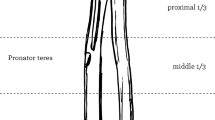Abstract
Purpose
Radio-carpal fracture dislocations are rare severe injuries typically seen following high energy trauma. This injury is characterized by complete dislocation of the radio-carpal joint with avulsion fracture of dorsal or palmar cortical rim of the distal radius combined with disruption of the radio-carpal ligament complex. The purpose of our study is to assess the radiological motion outcome of the radio-carpal joint after Moneim type 1 radio-carpal fracture dislocations following surgical treatment.
Patients and methods
Only Moneim type 1 injuries were included in this study. Eight patients with Moneim type 1 injuries were identified by retrospective examination of our fracture registry and included in this study. All patients were initially treated with closed reduction and plaster immobilization. CT scans were performed after reduction. Operative treatment consisted of anatomic reduction of the distal radial rim fractures and fixation with a small T-plate through a dorsal approach. Cancellous bone graft was utilized if necessary to support the articular surface. Repair of the palmar radio-carpal ligament complex was performed through a palmar wrist approach. Antero-posterior, lateral, as well as lateral flexion and extension radiographs were taken at an average follow-up of 4.1 years.
Results
Follow-up radiologic evaluation of standard lateral radiograph revealed a mean scapholunate angle of 55.6°. The mean capitolunate angle was found to be −11.6° and the mean radio-capitate angle was 10.5°. The average noted angles in maximum flexion were as follows: radiolunate 15.3°, capitolunate 18° and radiocapitate 30°. The average angles in maximum extension were: radiolunate −23.9°, capitolunate −31° and radiocapitate −55°. At follow-up, arthritic changes were assessed radiographically using the classification described by Knirk and Jupiter. Fifty-six percent of the patients were found to exhibit stage 1 traumatic arthritis, 33% had stage 2 traumatic arthritis and 11% exhibited stage 3 traumatic arthritis with radio-carpal joint space obliteration.
Conclusion
Rigid bony fixation and palmar radio-carpal ligament repair of Moneim Type 1 radio-carpal dislocations resulted in preservation of sagittal plane motion of the proximal carpal row in eight of nine cases. Our data suggest that surgical reconstruction of Moneim type 1 injuries is the preferred treatment and usually leads to satisfactory range of motion.


Similar content being viewed by others
References
Dunn AW (1972) Fractures and dislocations of the carpus. Surg Clin North Am 52(6):1513–1538
Fernandez DL, Ghillani R (1987) External fixation of complex carpal dislocations: a preliminary report. J Hand Surg [Am] 12(3):335–347
Kaufmann RA, Pfaeffle HJ, Blankenhorn BD, Stabile K, Robertson D, Goitz R (2006) Kinematics of the midcarpal and radio-carpal joint in flexion and extension: an in vitro study. J Hand Surg [Am] 31(7):1142–1148. doi:10.1016/j.jhsa.2006.05.002
Lutz M, Rudisch A, Kralinger F, Smekal V, Goebel G, Gabl M, Pechlaner S (2005) Sagittal wrist motion of carpal bones following intraarticular fractures of the distal radius. J Hand Surg [Br] 30(3):282–287. doi:10.1016/j.jhsb.2004.12.012
Knirk JL, Jupiter JB (1986) Intra-articular fractures of the distal end of the radius in young adults. J Bone Joint Surg Am 68(5):647–659
Garcia-Elias M, An KN, Amadio PC, Cooney WP, Linscheid RL (1989) Reliability of carpal angle determinations. J Hand Surg [Am] 14(6):1017–1021
Gabl M, Lutz M, Pechlaner S, Fink C (1996) Perilunate dislocation and dislocation fractures—results of surgical management. Unfallchirurg 99(9):650–655. doi:10.1007/s001130050038
Herzberg G, Forissier D (2002) Acute dorsal trans-scaphoid perilunate fracture-dislocations: medium-term results. J Hand Surg [Br] 27(6):498–502. doi:10.1054/jhsb.2002.0774
Cooney WP, Bussey R, Dobyns JH, Linscheid RL (1987) Difficult wrist fractures. Perilunate fracture-dislocations of the wrist. Clin Orthop Relat Res 214:136–147
Moneim MS, Bolger JT, Omer GE (1985) Radio-carpal dislocation—classification and rationale for management. Clin Orthop Relat Res 192:199–209
Ilyas AM, Mudgal CS (2008) Radio-carpal fracture-dislocations. J Am Acad Orthop Surg 16(11):647–655
Author information
Authors and Affiliations
Corresponding author
Additional information
An erratum to this article can be found at http://dx.doi.org/10.1007/s00402-012-1492-9
Rights and permissions
About this article
Cite this article
Oberladstätter, J., Arora, R., Dallapozza, C. et al. Radiological radio-carpal and mid-carpal motion after operative treatment of dorsal radio-carpal fracture dislocations. Arch Orthop Trauma Surg 130, 77–81 (2010). https://doi.org/10.1007/s00402-009-0902-0
Received:
Published:
Issue Date:
DOI: https://doi.org/10.1007/s00402-009-0902-0




